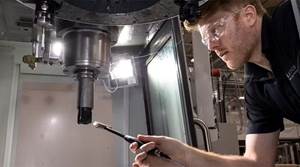Cutting Tools For High Speed Milling Of Aluminum
Go with the flow—chip flow, that is. The uninterrupted flow of the soft aluminum chip determines the design of the end mills that Metlfab uses.
Share





The faster you mill a pocket in a billet of any of the commonly machined aluminum alloys, the more important it is for the cutting tool to provide a wide and easy path for the chip to escape. In fact, tools that have fewer flutes tend to be more productive for this very reason—the wider flute spacing provides more clearance. High speed machining of aluminum is one application in which a one-flute end mill may actually be the most productive.
Netherlands-based Seco-Jabro Tools supplies a one-flute solid carbide end mill. Seco-Jabro’s U.S. agent, Seco-Tesco (Hayes, Virginia), has provided much of the tooling that performs well in Metlfab’s new-from-the-ground-up process for high speed machining of aluminum (detailed in the article under "Editor Picks" at right). Metlfab did not choose the one-flute tool; the asymmetrical cutter demands off-line balancing for use at high spindle speeds, and the shop didn’t want to implement this extra step. However, the design of a Seco-Jabro two-flute tool used at Metlfab illustrates some of the same features. Eric Gardner, Seco-Tesco’s product manager for milling, explains how the tool design assists in milling aluminum rapidly.
Chip flow is paramount, he says. In high speed machining of other materials—most notably the tool steels that figure into die/mold applications—a major challenge is the heat. In high speed machining of aluminum, by contrast, a major challenge is the tendency of the soft material to adhere to the cutting edge. The die/mold high speed machining end mill may use a coating that acts as a thermal barrier. However, if the end mill for aluminum uses a coating at all, it is likely to use one chosen more for its lubricity than for its thermal effect. More significantly, the geometry of the tool facilitates chip flow—essentially by keeping the tool out of the chip’s way.
For example, the flute design avoids sudden changes in the path of the chip. In this, the flute follows a principal similar to that of the tool path in high speed machining. While the tool path for high feed rates features rounded corners and gradual changes in direction to avoid shocking the tool, the tool that mills aluminum at high speeds features a smooth rake face and a somewhat slower helix for a similar reason—to avoid sharp transitions that might impede the movement of the chip.
The tool also features deep flutes that provide the chip with gullies that are more open. The value of this clearance for the chip is the reason why a one-flute tool may be successful. Having just one flute allows the gully corresponding to the flute to be ground past the tool’s centerline—a feature that can allow the 13-mm version of this tool to operate at a feed of 0.060 ipt, Mr. Gardner says. A two-flute tool obviously can’t permit so much flute clearance, but the two-flute end mill used in aluminum might have gullies so deep that the core of the tool accounts for only 20 percent of the tool’s diameter.
Such a tool may appear too delicate for high metal removal rates. Appearances can be deceiving, however. Mr. Gardner says a more conventional tool that appears more solid is likely to trap aluminum chips quickly, therefore performing much less effectively in the aluminum milling application.
Plus, Metlfab applies tooling such as this in a way that optimizes its rigidity. With machines having 145 tool magazine positions devoted to standard tooling, there is room within the shop’s standard kit to stock the same tool variety at different lengths. This gives the shop’s programmers freedom to select the shortest tool length that a particular cut will allow. Mr. Gardner sees this as an example of one more vital factor in any cutting tool’s success: having a process in place around the tool that is able to fully realize the tool’s potential.
Related Content
Ceratizit Product Update Enhances Cutting Tool Solutions
The company has updated its MaxiMill 273-08 face mill, WPC – Change Drill, as well as the HyPower Rough and HyPower Access 4.5-degree hydraulic chucks.
Read MoreHow to Mitigate Chatter to Boost Machining Rates
There are usually better solutions to chatter than just reducing the feed rate. Through vibration analysis, the chatter problem can be solved, enabling much higher metal removal rates, better quality and longer tool life.
Read MoreKennametal's Expanded Tooling Portfolio Improves Performance
The company has launch eight new products that expand on and support existing platforms across multiple applications.
Read MoreRead Next
Everything Changes
Through a sweeping transition to high speed machining, a Maryland contract shop realizes its goal of same-day, "in by 9, out by 5" turnaround.
Read MoreMachine Shop MBA
Making Chips and 91ÊÓƵÍøÕ¾ÎÛ are teaming up for a new podcast series called Machine Shop MBA—designed to help manufacturers measure their success against the industry’s best. Through the lens of the Top Shops benchmarking program, the series explores the KPIs that set high-performing shops apart, from machine utilization and first-pass yield to employee engagement and revenue per employee.
Read MoreLast Chance! 2025 Top Shops Benchmarking Survey Still Open Through April 30
Don’t miss out! 91ÊÓƵÍøÕ¾ÎÛ's Top Shops Benchmarking Survey is still open — but not for long. This is your last chance to a receive free, customized benchmarking report that includes actionable feedback across several shopfloor and business metrics.
Read More























